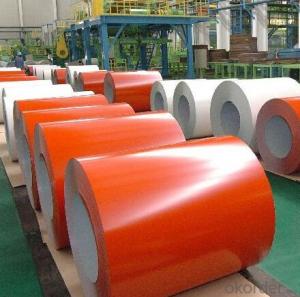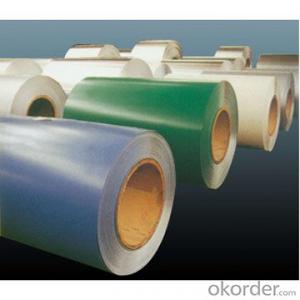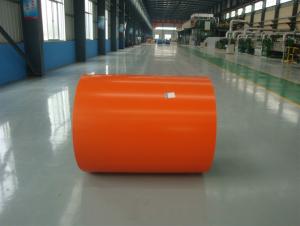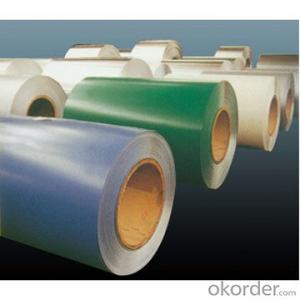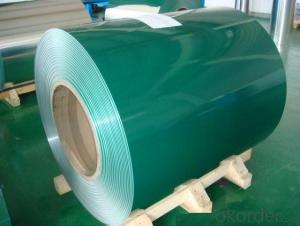PRE-PAINTED ALUZINC STEEL COIL
- Loading Port:
- China Main Port
- Payment Terms:
- TT OR LC
- Min Order Qty:
- -
- Supply Capability:
- -
OKorder Service Pledge
Quality Product, Order Online Tracking, Timely Delivery
OKorder Financial Service
Credit Rating, Credit Services, Credit Purchasing
You Might Also Like
THICKNESS:0.18mm-1.5mm
WIDTH:900mm-1250mm
COATING MASS:AZ30-AZ180
PAINT:PE、HP、HDP、PVDF、SMP、MATT、PVDF
COLOR:RAL Scale
COIL INNER DIAMETER:508mm/610mm
COIL WEIGHT:3mt-7mt
BASE MATERIAL:Hot-dip Aluzinc Steel
WIDTH:900mm-1250mm
COATING MASS:AZ30-AZ180
PAINT:PE、HP、HDP、PVDF、SMP、MATT、PVDF
COLOR:RAL Scale
COIL INNER DIAMETER:508mm/610mm
COIL WEIGHT:3mt-7mt
BASE MATERIAL:Hot-dip Aluzinc Steel
- Q: How are steel coils inspected for surface quality?
- Steel coils are inspected for surface quality through a meticulous process that involves various methods and technologies. The inspection is crucial as it ensures the coils meet the required standards and are free from any defects or imperfections. Here are the steps involved in inspecting steel coils for surface quality: 1. Visual Inspection: Initially, the coils undergo a visual inspection where trained personnel visually examine the entire surface for any visible defects such as scratches, dents, or any irregularities. This step helps identify any obvious issues that can be detected through visual observation. 2. Magnetic Particle Inspection: This non-destructive testing method involves applying a magnetic field to the steel coil's surface and then applying a magnetic particle solution. Any surface cracks or defects will cause the magnetic particles to cluster, making them visible under proper lighting. This technique is highly effective in detecting surface cracks and other surface abnormalities. 3. Eddy Current Testing: This method of inspection utilizes electromagnetic induction to identify surface defects. An eddy current probe is passed over the steel coil's surface, and any variations in the electrical current induced by the magnetic field will be detected. This technique is particularly useful for detecting surface cracks, pits, or corrosion on the coil's surface. 4. Ultrasonic Testing: Ultrasonic waves are used to inspect the steel coil's surface for any hidden defects such as subsurface cracks or inclusions. High-frequency sound waves are transmitted into the material, and any changes in the sound wave pattern that are reflected back indicate the presence of defects. Ultrasonic testing is highly reliable and can detect even the smallest defects within the steel coil. 5. Surface Roughness Measurement: The surface roughness of the steel coil is measured using specialized equipment. This measurement helps determine if the surface meets the required smoothness standards. The equipment scans the surface and provides detailed information about the roughness, enabling the inspector to ensure it falls within the acceptable range. Overall, steel coils undergo a comprehensive inspection process that combines visual examination with advanced testing methods such as magnetic particle inspection, eddy current testing, ultrasonic testing, and surface roughness measurement. These inspection techniques help identify and evaluate any potential defects or surface irregularities, ensuring that the steel coils meet the required surface quality standards.
- Q: Is steel harder than iron or is iron harder than steel?Please explain... and help!Thanks
- steel is harder than iron Iron is a chemical element. It is a strong, hard, heavy gray metal. It is found in meteorites. Iron is also found combined in many mineral compounds in the earth's crust. Iron rusts easily and can be magnetized and is strongly attracted to magnets. It is used to make many things such as gates and railings. Iron is also used to make steel, an even harder and tougher metal compound. Steel is formed by treating molten (melted) iron with intense heat and mixing it (alloying) with carbon. Steel is used to make machines, cars, tools, knives, and many other things.
- Q: Want to get stainless steel sink. I want quality, durability, quiet, etc. Any suggestions??
- Yes, it’s a good idea to look for the best brand of stainless steel sink as it is used in various purposes regularly. Top brand of stainless steel is naturally longer lasting and capable of bearing lot of pressure then normal stainless steel sink. You must see top brands as well as their prices before buying any.
- Q: What are the factors to consider when selecting steel coils for a specific application?
- There are numerous factors to consider when choosing steel coils for a particular application. These factors encompass the type of application, the necessary strength and durability, the desired aesthetic appearance, the allocated budget, and any specific industry standards or regulations that must be met. Firstly, it is crucial to identify the type of application for which the steel coils will be utilized. Various applications may necessitate different steel types with varying properties. For instance, if the coils are intended for use in structural construction, high-strength steel with exceptional structural integrity may be necessary. Conversely, if the coils will be employed in automotive manufacturing, steel with good formability and weldability may be more appropriate. The required strength and durability represent another crucial factor to contemplate. This includes factors such as load-bearing capacity, resistance to corrosion, and the ability to withstand extreme temperatures or environmental conditions. The selected steel coils must be capable of enduring the specific stresses and strains inherent in the intended application. The desired aesthetic appearance is also significant, particularly in applications where the steel coils will be visible. Considerations may include the surface finish, color, and texture of the steel coils. This consideration is especially pertinent in industries such as architecture or interior design, where the visual appeal of the steel plays a pivotal role. Budgetary constraints should also be taken into account when selecting steel coils. The price of different steel grades and types can vary significantly. Striking a balance between desired properties and available budget is important. In some cases, compromising on certain factors may be necessary in order to adhere to financial limitations. Lastly, any specific industry standards or regulations must be considered during the selection process. Certain industries, such as aerospace or automotive, may impose strict requirements on the materials used in their products. It is essential to ensure that the chosen steel coils meet all necessary standards and regulations in such cases. In conclusion, when choosing steel coils for a specific application, careful consideration should be given to factors such as the type of application, required strength and durability, desired aesthetic appearance, budget, and industry standards or regulations. By taking these factors into account, an informed decision can be made to select the most suitable steel coils for the intended application.
- Q: Is sterling silver better than surgical steel as far as being hypoallergic in earrings? If I have a choice which should I get? Thanks!
- Surgical okorder /
- Q: i would like to know of any companies who buy shredded scrap steel
- We are one of the biggest steel mills in Asia. Under our group, we have steel mills in Thailand and Bangladesh. On the monthly basis, we purchase steel scrap HMS1/2 80:20 and the shredded ISRI210/211, ISRI211 by bulk and 20' container to Thailand and Bangladesh. Due to the limitation of our existing shredded steel scrap supplier, we need to get more supply of the shredded. Please contact us or offer us of ISRI 210/211 or ISRI211 CFR Chittagong, Bangladesh with 500mt - 2000mt per shipment by 20' container. If any questions, please feel free to contact us.
- Q: What are the different methods of coil cutting for steel coils?
- There are several methods of coil cutting for steel coils, each with its own advantages and suitability for different applications. Here are some of the common methods: 1. Slitting: Slitting is the most commonly used method for coil cutting. It involves passing the steel coil through a set of rotating circular blades that cut the coil into narrower strips. This method is suitable for producing narrow width strips with precise dimensions. 2. Shearing: Shearing is another method used for coil cutting, especially for thicker gauge coils. It involves using a straight blade to cut the coil along a straight line. Shearing is suitable for producing larger width strips and is often used for heavier gauge steel coils. 3. Laser Cutting: Laser cutting utilizes a high-powered laser beam to cut through the steel coil. This method offers a high degree of precision and can be used to cut complex shapes and patterns. Laser cutting is often used for specialized applications where accuracy and fine details are crucial. 4. Waterjet Cutting: Waterjet cutting involves using a high-pressure jet of water mixed with abrasive particles to cut through the steel coil. This method is versatile and can be used for cutting various materials, including steel. Waterjet cutting is suitable for producing clean and precise cuts without heat-affected zones. 5. Plasma Cutting: Plasma cutting utilizes a high-temperature plasma arc to melt through the steel coil. This method is efficient and can be used for cutting thick gauges of steel. Plasma cutting can achieve high cutting speeds, making it suitable for industrial applications. 6. Guillotine Cutting: Guillotine cutting involves using a guillotine-like mechanism to cut through the steel coil. The coil is placed on a table, and a blade descends vertically to cut through it. Guillotine cutting is suitable for producing straight and accurate cuts with minimal burrs. The choice of coil cutting method depends on various factors such as the desired width and thickness of the strips, required precision, production volume, and the specific application. It is important to consider these factors and consult with experts to determine the most suitable coil cutting method for a particular steel coil.
- Q: For my homework we have to fill out a table, but I cannot find some basic uses of these types of steel anywhere:Low carbon steel (iron mixed with lt;0.25% carbon)High carbon steel (iron mixed with lt;1.5% carbon)Stainless steel (iron mixed with nickle an chromium)Titanium steel (iron mixed with titanium)Manganese steel (iron mixed with manganese) Thanks :)
- Low okorder / You say you cannot find there uses anywhere. These all came up using the simplest of web searches. You really need to have a word with your IT teacher as clearly you are not doing basic searches properly.
- Q: mass of steel ball=66.80 gramsdiameter of steel ball=2.51 cm
- To calculate the density of any object you will always use the formula: Density = Mass / Volume (P=M/V). You have recorded the known values of the mass and the diameter of the ball (sphere), so we have everything needed to calculate the Density. Mass is 66.80g, but we shall need to use another formula to calculate the volume of the sphere. The formula to use is 4/3 X Pi X radius cubed. However, first of all we need to turn your measurement of the diameter of the steel sphere into the radius of the steel sphere (So that it can be substituted in place of the “radius” in the above formula). Simply half the diameter to find the radius. So 2.51 cm divided by 2 is 1.255 cm. Now insert the radius 1.255cm into the above formula. It would be read like this: 4/3 X 3.14159… X 1.255 ?cubed (OR 4/3 X 3.14159 X 1.255X1.255X1.255), = 8.2798. So, now we know that the sphere has a volume of 8.2798 cm cubed, we can use this number in place of the “V” in the density formula P=M/V, and we can also substitute in the Mass (66.80g). So now P=66.80 / 8.2798, which = 8.07g/cm cubed. Now we know that from your measurements, steel has a density of 8.07g/cm cubed! This is fairly close to the real life average density, which if I remember correctly is around 7.8 g/cm cubed. Just remember, though, that as steel is an alloy it’s density is not standard and varies due to carbon content etc. Anyway, I hope that helped you!
- Q: How are steel coils used in the manufacturing of HVAC systems?
- Steel coils are used in the manufacturing of HVAC systems as they serve as the main component of heat exchangers, which are responsible for transferring heat between the air and refrigerant. The steel coils provide a sturdy and durable structure for the heat exchanger while also allowing for efficient heat transfer, ensuring optimal performance in heating and cooling processes.
Send your message to us
PRE-PAINTED ALUZINC STEEL COIL
- Loading Port:
- China Main Port
- Payment Terms:
- TT OR LC
- Min Order Qty:
- -
- Supply Capability:
- -
OKorder Service Pledge
Quality Product, Order Online Tracking, Timely Delivery
OKorder Financial Service
Credit Rating, Credit Services, Credit Purchasing
Similar products
Hot products
Hot Searches
Related keywords

















